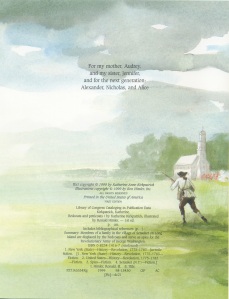Recently an envelope arrived in the mail from the literary agency that represented my earliest published work. Only one of those titles, my 1999 picture book Redcoats and Petticoats, remains in print.
When royalties start to dwindle, an out-of-print notice usually follows. It seemed to me I had a fifty percent chance of receiving disappointing news about Redcoats and, especially since I was about to leave for London the next morning, I decided not to open the envelope. Several weeks later, home again but caught up in busyness, I continued to shelve the envelope and any feelings of sorrow that might come from discovering its contents.
Finally, one evening I felt ready to face what the wheel of fortune had dealt me. As I took out my paper knife, a favorite Buddhist teaching popped into my mind: “The dharma wheel turns, pay no mind to it.” In other words, when we’re down we’re on the way up and vice versa, so knowing that ever-changing state of things let’s try to live with grace, trust, and equanimity. Somewhere, at the center of the wheel, I reminded myself, there’s always a place of peace.
I’d hoped to find a check of at least six hundred dollars. I feared I’d receive a hundred or less. The check in my hand amounted to nearly four thousand dollars. Woo-hoo! Score! I could hardly believe it. Then I remembered that the subject of my book, George Washington’s spies on Long Island, had been featured in a recent AMC television series, “Turn.” Obviously, the public’s renewed interest in the topic accounted for my boon in sales.
I laughed so hard I felt giddy. I told one of my daughters what happened. Grinning, she gave me the thumbs up. I giggled some more, at the sheer surprise of the news, but also at myself for the way I’d behaved by waiting to open the envelope.

Redcoats and Petticoats, published by Holiday House, Inc., and illustrated by Ronald Himler, has continuously been in print in hardcover since 1999. Privately owned and managed, Holiday House remains one of the few independent book publishers in New York.
* * * * *
Redcoats and Petticoats tells the real-life story of a brave woman named Anna (Nancy) Strong who used her clothesline to help her group of fellow undercover agents relay news to General George Washington. I’ve known the story as long as I can remember. I don’t think it’s possible to grow up, as I did, in the Three Villages of Stony Brook, Setauket, and Old Field, on the north shore of Long Island, New York, without knowing of our beloved Setauket Spy Ring. This handful of heroic citizens, via a person-to-person assembly, on foot and by horseback, by rowboat, and finally by whaleboat across Long Island Sound to Washington’s headquarters in Fairfield, Connecticut, passed on news of Tory battle plans that secret agents had overheard in the tearooms and taverns of the city of New York. In Setauket, sixty-three miles from the city, Nancy Strong did her part by signaling to a fellow spy a code that indicated the rendezvous spot in one of the nearby coves, where the secret missives would be waiting for a whaleboat captain to row them across the Sound to Patriot shores.
As part of a fourth-grade school assignment, my mother took me to meet Kate Strong, a blind woman, by then well into her nineties, the great-great-granddaughter of the famous clothesline patriot. The essay I wrote subsequently won me my first award in a writing contest sponsored by the Long Island chapter of the Daughters of the American Revolution. No doubt this early recognition contributed to my becoming a writer.

The locations in Redcoats and Petticoats, beautifully and accurately rendered by artist Ronald Himler, serve as fixed points in my childhood. The Setauket Neighborhood House on Main Street, where George Washington paid a visit, was where I’d taken ballet and where my mother attended historical society functions. In the waters off Strong’s Neck, near the spot where Nancy Strong hung her clothesline, I’d clammed its muddy shallows, rowed, sailed, and, with my high-school chum Elke Dee, learned to water-ski. In the summers during college, and after, I spent many happy evenings star-gazing, boating, and barbecuing with my dear friend Lisa Lesko and her family.
The book’s opening spread shows the Battle of Setauket on the Village Green, in front of the Setauket Presbyterian Church. Here my parents, Audrey and Dale Kirkpatrick, performed marionette shows at church fairs. And here, loudly bellowing traditional Highland melodies, a bagpiper opened and concluded our family weddings, including my own in the same year Redcoats was published. Six years later, in the church cemetery where the Tories camped and uprooted tombstones to use as cooking tables, my father was buried, and four years after that, my mother laid to rest beside him.

The present Setauket Presbyterian Church structure was built in 1812. Its graveyard dates to the 1660s.
Writing the book put me in touch with our distant Revolutionary War past. Reflecting on the book now puts me in touch with my own past, the flow of my life, and the lives of many dear to me. Through beloved local landmarks, I see and appreciate the distances we’ve traveled, and the well-worn, age-old paths still ahead of us.
I’m so grateful that my book has beaten the odds in the competitive venue of publishing and I now celebrate its fifteenth anniversary. Viva Redcoats and Petticoats!














